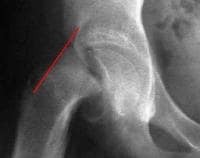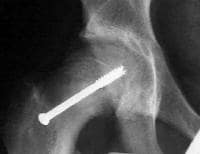Background
Slipped capital femoral epiphysis (SCFE) is one of the most important pediatric and adolescent hip disorders encountered in medical practice.[1, 2, 3, 4] Although SCFE is a rare condition, an accurate diagnosis combined with immediate treatment is critical.[5, 6] Despite the fact that the underlying defect may be multifactorial (eg, mechanical and constitutional factors), SCFE represents a unique type of instability of the proximal femoral growth plate. Clinically, the patient may report hip pain, medial thigh pain, and/or knee pain; an acute or insidious onset of a limp; and decreased range of motion of the hip.
On plain radiographs, the femoral head is seen displaced, posteriorly and inferiorly in relation to the femoral neck and within the confines of the acetabulum.[7] Treatment is primarily operative internal fixation. The goal is to prevent complications such as avascular necrosis (AVN).[2, 8, 9, 10]
 A Klein line is a line drawn along the superior border of the femoral neck that would normally pass through a portion of the femoral head. If not, slipped capital femoral epiphysis is diagnosed.
A Klein line is a line drawn along the superior border of the femoral neck that would normally pass through a portion of the femoral head. If not, slipped capital femoral epiphysis is diagnosed.  X-ray of a hip following operative percutaneous fixation of a slipped capital femoral epiphysis. NextEpidemiologyFrequencyUnited States
X-ray of a hip following operative percutaneous fixation of a slipped capital femoral epiphysis. NextEpidemiologyFrequencyUnited StatesThe overall incidence for SCFE in the United States is 10.8 cases per 100,000 children.[11] The incidence rate in boys (13.35 per 100,000) is higher than in girls (8.07 per 100,000). When compared with white children, black children have a higher incidence rate at 3.94 times, and Hispanic children have a 2.54 times higher incidence rate.
Rates of SCFE per 100,000 children are higher in the Northeast (17.15) and West (12.70) than in the Midwest (7.69) and South (8.12).[12] Evidence also points to a seasonal variation in SCFE occurrence. In areas north of 40º latitude, 57.4% of SCFEs occurred during the summer, whereas in areas south of 40º latitude, 57.3% of SCFEs occurred during the winter months.[11]
SCFE mainly occurs between the ages of 10 and 16 years.[1, 11] A slight downward trend has occurred for average ages over several years, with some data finding the average age for boys at 12.7 years and girls at 11.2 years. This change could be due to the phenomenon of children maturing at a younger age.[13]
In general, about 20% of patients have bilateral involvement at the time of presentation. It is felt that an additional 20-40% will subsequently progress to bilateral slips. When the presentation is sequential, the second hip usually presents within 18 months of the first SCFE.[14, 15]
The risk of SCFE is increased in children who are obese, as well as in children with other medical issues such as hypothyroidism, low growth hormone level, pituitary tumors, craniopharyngioma, Down syndrome, renal osteodystrophy, and adiposogenital syndrome.
InternationalIn a study by Benson et al, the investigators reexamined the incidence of SCFE in New Mexico (previous studies had reported almost a 5-fold lower incidence of SCFE in New Mexico compared with Connecticut). The discharge databases for the 11 major medical centers in New Mexico from 1995 to 2006 were analyzed by comparison with the 2000 New Mexico census data. The incidence data are reported as cases per 100,000 boys aged 10-17 years and girls aged 8-15 years, as per the earlier study data.[16]
The investigators found an incidence rate of SCFE in New Mexico for the study period was 5.99, which was a statistically significant change that was more than double the reported incidence in the 1960s (2.13). Obesity was noted as a patient factor that changed since 1971 (tripled), although the national incidence of SCFE appeared to have remained fairly constant at 10.8 per 100,000. Benson et al theorized that "increased obesity in children and improved access to pediatric orthopaedic evaluation may have contributed to a significant increase in reported incidence of SCFE in New Mexico."[16]
PreviousNextFunctional AnatomySCFE results from a Salter-Harris type physeal fracture. In patients with SCFE, the epiphyseal growth plate is unusually widened, primarily due to expansion of the zone of hypertrophy. The hypertrophic zone, which constitutes 15-30% of the normal physis, can account for up to 80% of the width of the physeal plate in affected patients. Histologically, abnormal cartilage maturation, endochondral ossification, and perichondral ring instability occur. This leads to less organization of the normal cartilaginous columnar architecture. Slippage occurs through this weakened area.
The position of the proximal physis normally changes from horizontal to oblique during preadolescence and adolescence, redirecting hip forces from compression forces to shear forces. There is an association between femoral neck retroversion and a reduced neck-shaft angle with SCFE. These changes can increase the shear forces across the hip, leading to SCFE.[17] Other concomitant findings in the hip include inflammatory synovitis and disorganized collagen fibrils with accumulations of proteoglycans and glycoproteins within the growth plate; however, whether these changes are a cause or a result of SCFE remains undetermined.
PreviousProceed to Clinical Presentation , Slipped Capital Femoral Epiphysis






0 comments:
Post a Comment
Note: Only a member of this blog may post a comment.